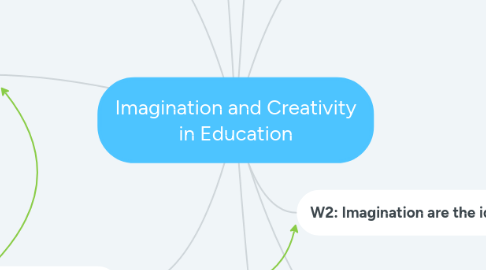
1. W4: Creative Practice
1.1. Visible through inspiration and flow
1.2. Pedagogies and learning experiences creates limitations
1.3. W5: Will think outside of the box
1.3.1. Critical Reflection, problem solves
2. W2: Ideas are fluid
2.1. An idea is a network
2.2. Collaboration; sharing of ideas
2.3. Hunches connecting with other hunches
2.4. W7: Teachers and students learn from one another
2.4.1. Communication, Creativity, Collaboration and Critical Reflection practices
2.4.2. Create learning environments where there is constant dialogue
2.4.3. W10: Creative wheel through social interaction and constructivist approach
2.4.3.1. Must be in line with curriculum, though ensure to use out of the box strategies
2.4.3.2. Obserserve the interests of your students
3. W2: "The process of having original ideas that have value." Ken Robinson
3.1. Be prepared and open to make mistakes
3.2. Build on what the child already has
3.3. Build on their interests, passions and talent
3.4. Intelligence is diverse
4. W1: Unique to the Individual
5. W1: Creativity is the action
5.1. Tools for getting thoughts into the world
5.2. Provides motivators for creative outlet
5.3. W1: Creativity is the action
5.3.1. Tools for getting thoughts into the world
5.3.2. Provides motivators for creative outlet
5.4. W3: What might Creativity be?
5.4.1. It is the instrument
6. W2: Imagination are the ideas
6.1. Meaning of the world around a person
6.2. Is limitless and at times abstract
6.3. Facilitative process by educator
7. W3: Pedagogy & Curriculum
7.1. Educator's role in facilitating Imagination
7.2. Four C Model Application
7.3. W5: Create open ended experiences
7.3.1. W6: Merizow's Transformational Learning
7.3.1.1. It is evident when values, perspectives and beliefs change
7.3.1.2. Evident through school through Four C's approach
7.4. W8: Transform Culture
7.4.1. Impact Structure, Vision, Leadership and Pedagogical Practices
7.4.1.1. Collaborative Leadership
7.4.2. W11: Ensure to incorporate a plethora of cultural perspectives
7.4.2.1. Uphold and respect an individual's culture through practices that are in align with their values
7.4.2.2. Encourages respectful and global citizens
7.4.2.3. Attempt to cite the creators of chosen resources
8. W9: The Anomalous Curriculum
8.1. Critical Pedagogy influences..
8.1.1. Curriculum interpretation
8.1.2. Pedagogies
